Healthcare Workforce Distribution: Nursing Assessment 3 Project
VerifiedAdded on 2022/12/19
|18
|4152
|63
Project
AI Summary
This project plan addresses the critical issue of healthcare workforce distribution and supply in Australia. It begins with an introduction to the publicly funded healthcare system and identifies the shortage of medical practitioners and nurses, especially in rural areas. The plan justifies the problem's significance, citing the aging nursing workforce and the increasing reliance on foreign-trained professionals. A detailed situation assessment explores the shortage of medical practitioners, nurses, and native-born professionals. The literature analysis reviews the optimal workforce requirements, the dynamics of the nursing sector, and the impact of government initiatives like the HWA programs. The project plan proposes goals and objectives focused on public health nursing, particularly addressing the lack of nurses in remote areas. It outlines potential causes, including workforce shortages and an aging population, and suggests actions to be executed, such as increasing leadership capacity, improving retention strategies, and promoting innovation in nursing practices. The plan also sets criteria for further reflection and evaluation to ensure the project's effectiveness. The project aims to improve healthcare access and quality for all Australians, particularly those in underserved areas.
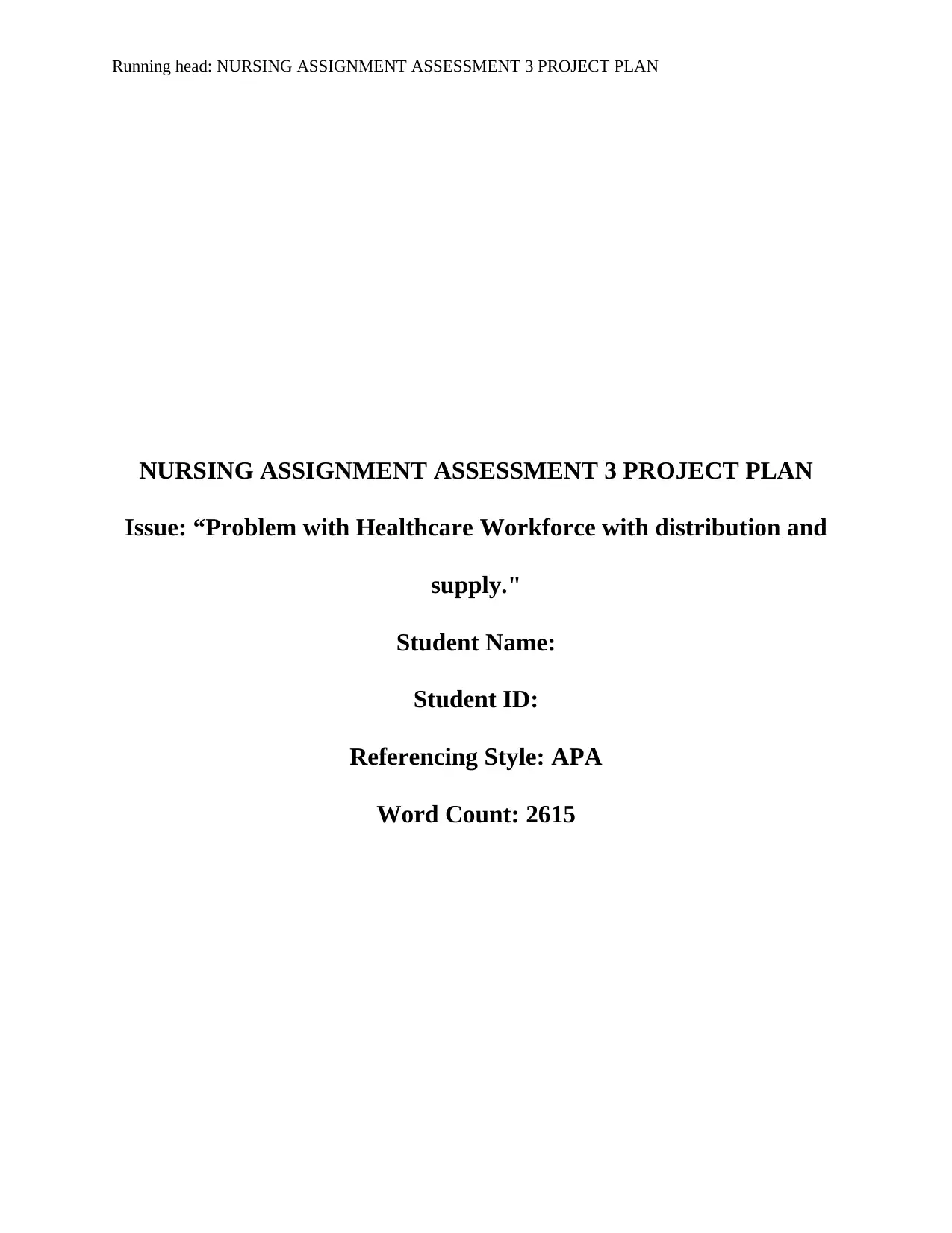
Running head: NURSING ASSIGNMENT ASSESSMENT 3 PROJECT PLAN
NURSING ASSIGNMENT ASSESSMENT 3 PROJECT PLAN
Issue: “Problem with Healthcare Workforce with distribution and
supply."
Student Name:
Student ID:
Referencing Style: APA
Word Count: 2615
NURSING ASSIGNMENT ASSESSMENT 3 PROJECT PLAN
Issue: “Problem with Healthcare Workforce with distribution and
supply."
Student Name:
Student ID:
Referencing Style: APA
Word Count: 2615
Secure Best Marks with AI Grader
Need help grading? Try our AI Grader for instant feedback on your assignments.
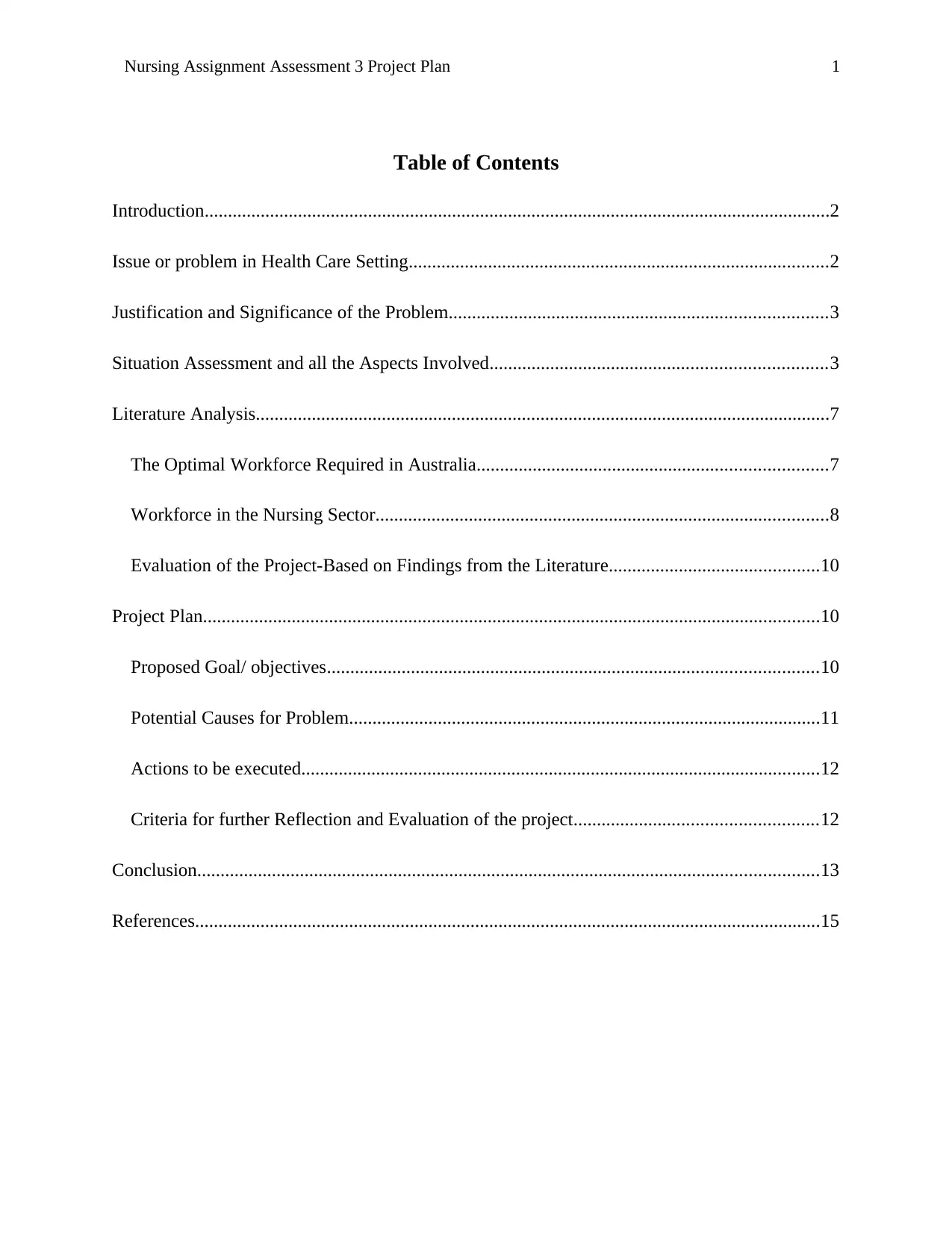
Nursing Assignment Assessment 3 Project Plan 1
Table of Contents
Introduction......................................................................................................................................2
Issue or problem in Health Care Setting..........................................................................................2
Justification and Significance of the Problem.................................................................................3
Situation Assessment and all the Aspects Involved........................................................................3
Literature Analysis...........................................................................................................................7
The Optimal Workforce Required in Australia...........................................................................7
Workforce in the Nursing Sector.................................................................................................8
Evaluation of the Project-Based on Findings from the Literature.............................................10
Project Plan....................................................................................................................................10
Proposed Goal/ objectives.........................................................................................................10
Potential Causes for Problem.....................................................................................................11
Actions to be executed...............................................................................................................12
Criteria for further Reflection and Evaluation of the project....................................................12
Conclusion.....................................................................................................................................13
References......................................................................................................................................15
Table of Contents
Introduction......................................................................................................................................2
Issue or problem in Health Care Setting..........................................................................................2
Justification and Significance of the Problem.................................................................................3
Situation Assessment and all the Aspects Involved........................................................................3
Literature Analysis...........................................................................................................................7
The Optimal Workforce Required in Australia...........................................................................7
Workforce in the Nursing Sector.................................................................................................8
Evaluation of the Project-Based on Findings from the Literature.............................................10
Project Plan....................................................................................................................................10
Proposed Goal/ objectives.........................................................................................................10
Potential Causes for Problem.....................................................................................................11
Actions to be executed...............................................................................................................12
Criteria for further Reflection and Evaluation of the project....................................................12
Conclusion.....................................................................................................................................13
References......................................................................................................................................15
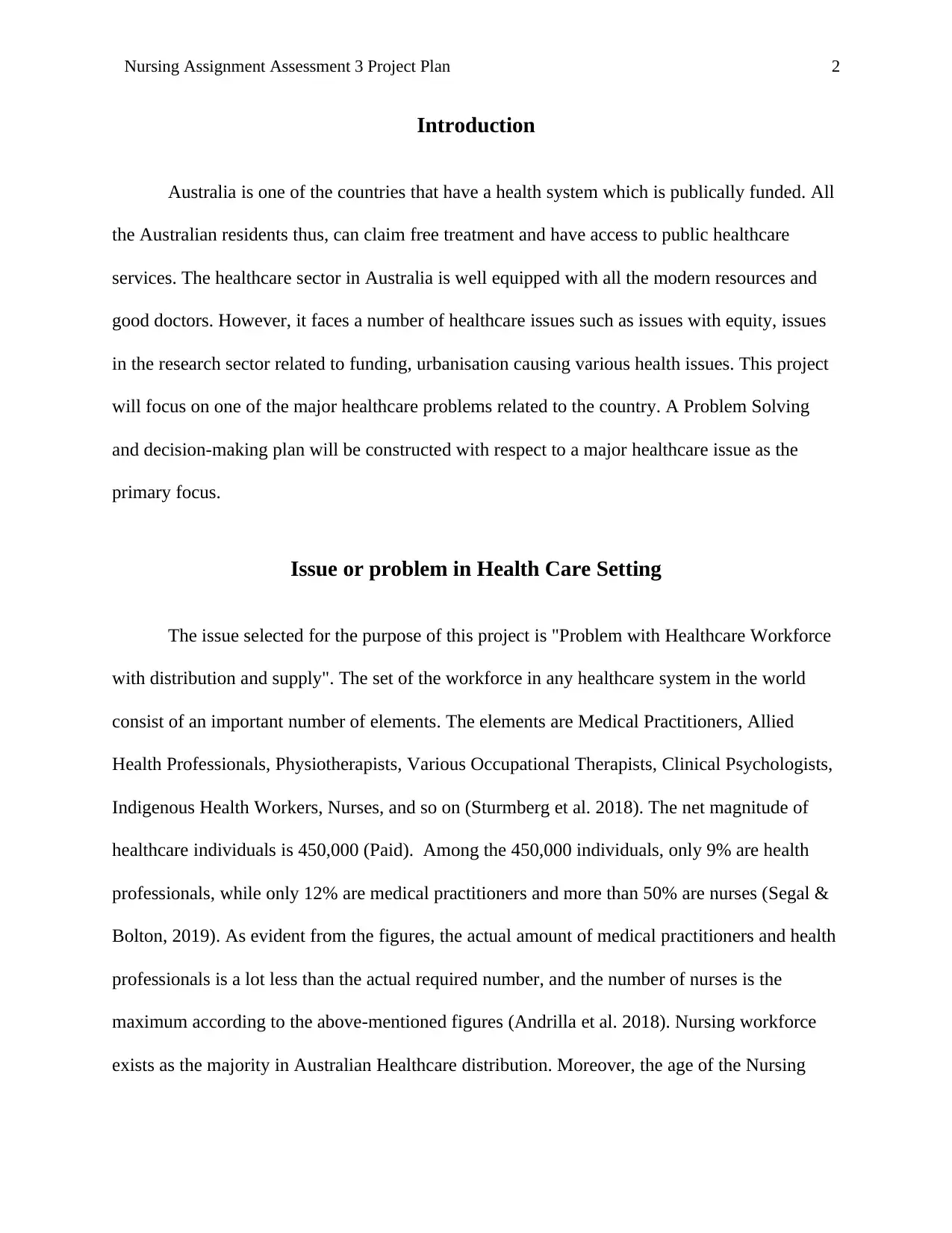
Nursing Assignment Assessment 3 Project Plan 2
Introduction
Australia is one of the countries that have a health system which is publically funded. All
the Australian residents thus, can claim free treatment and have access to public healthcare
services. The healthcare sector in Australia is well equipped with all the modern resources and
good doctors. However, it faces a number of healthcare issues such as issues with equity, issues
in the research sector related to funding, urbanisation causing various health issues. This project
will focus on one of the major healthcare problems related to the country. A Problem Solving
and decision-making plan will be constructed with respect to a major healthcare issue as the
primary focus.
Issue or problem in Health Care Setting
The issue selected for the purpose of this project is "Problem with Healthcare Workforce
with distribution and supply". The set of the workforce in any healthcare system in the world
consist of an important number of elements. The elements are Medical Practitioners, Allied
Health Professionals, Physiotherapists, Various Occupational Therapists, Clinical Psychologists,
Indigenous Health Workers, Nurses, and so on (Sturmberg et al. 2018). The net magnitude of
healthcare individuals is 450,000 (Paid). Among the 450,000 individuals, only 9% are health
professionals, while only 12% are medical practitioners and more than 50% are nurses (Segal &
Bolton, 2019). As evident from the figures, the actual amount of medical practitioners and health
professionals is a lot less than the actual required number, and the number of nurses is the
maximum according to the above-mentioned figures (Andrilla et al. 2018). Nursing workforce
exists as the majority in Australian Healthcare distribution. Moreover, the age of the Nursing
Introduction
Australia is one of the countries that have a health system which is publically funded. All
the Australian residents thus, can claim free treatment and have access to public healthcare
services. The healthcare sector in Australia is well equipped with all the modern resources and
good doctors. However, it faces a number of healthcare issues such as issues with equity, issues
in the research sector related to funding, urbanisation causing various health issues. This project
will focus on one of the major healthcare problems related to the country. A Problem Solving
and decision-making plan will be constructed with respect to a major healthcare issue as the
primary focus.
Issue or problem in Health Care Setting
The issue selected for the purpose of this project is "Problem with Healthcare Workforce
with distribution and supply". The set of the workforce in any healthcare system in the world
consist of an important number of elements. The elements are Medical Practitioners, Allied
Health Professionals, Physiotherapists, Various Occupational Therapists, Clinical Psychologists,
Indigenous Health Workers, Nurses, and so on (Sturmberg et al. 2018). The net magnitude of
healthcare individuals is 450,000 (Paid). Among the 450,000 individuals, only 9% are health
professionals, while only 12% are medical practitioners and more than 50% are nurses (Segal &
Bolton, 2019). As evident from the figures, the actual amount of medical practitioners and health
professionals is a lot less than the actual required number, and the number of nurses is the
maximum according to the above-mentioned figures (Andrilla et al. 2018). Nursing workforce
exists as the majority in Australian Healthcare distribution. Moreover, the age of the Nursing
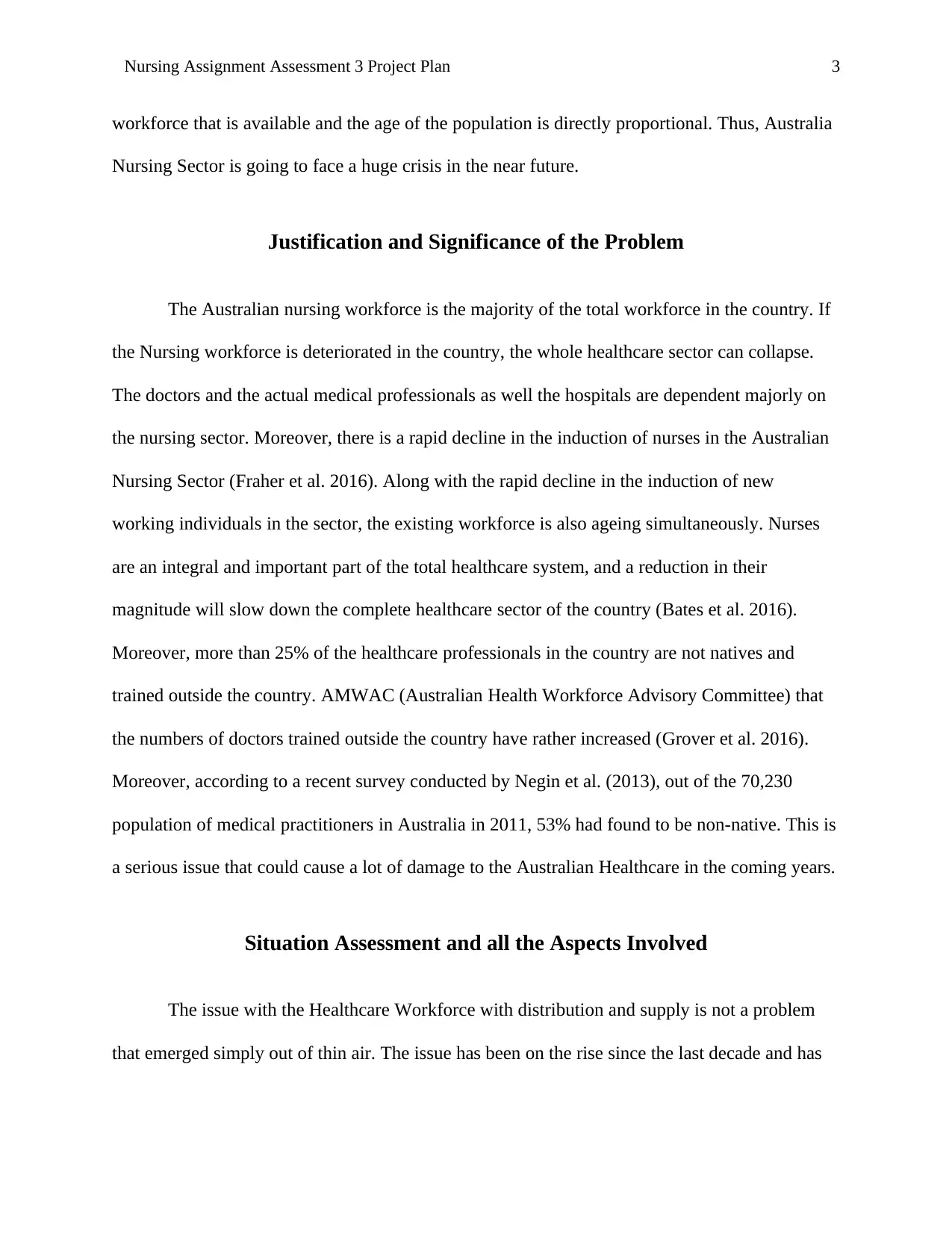
Nursing Assignment Assessment 3 Project Plan 3
workforce that is available and the age of the population is directly proportional. Thus, Australia
Nursing Sector is going to face a huge crisis in the near future.
Justification and Significance of the Problem
The Australian nursing workforce is the majority of the total workforce in the country. If
the Nursing workforce is deteriorated in the country, the whole healthcare sector can collapse.
The doctors and the actual medical professionals as well the hospitals are dependent majorly on
the nursing sector. Moreover, there is a rapid decline in the induction of nurses in the Australian
Nursing Sector (Fraher et al. 2016). Along with the rapid decline in the induction of new
working individuals in the sector, the existing workforce is also ageing simultaneously. Nurses
are an integral and important part of the total healthcare system, and a reduction in their
magnitude will slow down the complete healthcare sector of the country (Bates et al. 2016).
Moreover, more than 25% of the healthcare professionals in the country are not natives and
trained outside the country. AMWAC (Australian Health Workforce Advisory Committee) that
the numbers of doctors trained outside the country have rather increased (Grover et al. 2016).
Moreover, according to a recent survey conducted by Negin et al. (2013), out of the 70,230
population of medical practitioners in Australia in 2011, 53% had found to be non-native. This is
a serious issue that could cause a lot of damage to the Australian Healthcare in the coming years.
Situation Assessment and all the Aspects Involved
The issue with the Healthcare Workforce with distribution and supply is not a problem
that emerged simply out of thin air. The issue has been on the rise since the last decade and has
workforce that is available and the age of the population is directly proportional. Thus, Australia
Nursing Sector is going to face a huge crisis in the near future.
Justification and Significance of the Problem
The Australian nursing workforce is the majority of the total workforce in the country. If
the Nursing workforce is deteriorated in the country, the whole healthcare sector can collapse.
The doctors and the actual medical professionals as well the hospitals are dependent majorly on
the nursing sector. Moreover, there is a rapid decline in the induction of nurses in the Australian
Nursing Sector (Fraher et al. 2016). Along with the rapid decline in the induction of new
working individuals in the sector, the existing workforce is also ageing simultaneously. Nurses
are an integral and important part of the total healthcare system, and a reduction in their
magnitude will slow down the complete healthcare sector of the country (Bates et al. 2016).
Moreover, more than 25% of the healthcare professionals in the country are not natives and
trained outside the country. AMWAC (Australian Health Workforce Advisory Committee) that
the numbers of doctors trained outside the country have rather increased (Grover et al. 2016).
Moreover, according to a recent survey conducted by Negin et al. (2013), out of the 70,230
population of medical practitioners in Australia in 2011, 53% had found to be non-native. This is
a serious issue that could cause a lot of damage to the Australian Healthcare in the coming years.
Situation Assessment and all the Aspects Involved
The issue with the Healthcare Workforce with distribution and supply is not a problem
that emerged simply out of thin air. The issue has been on the rise since the last decade and has
Secure Best Marks with AI Grader
Need help grading? Try our AI Grader for instant feedback on your assignments.
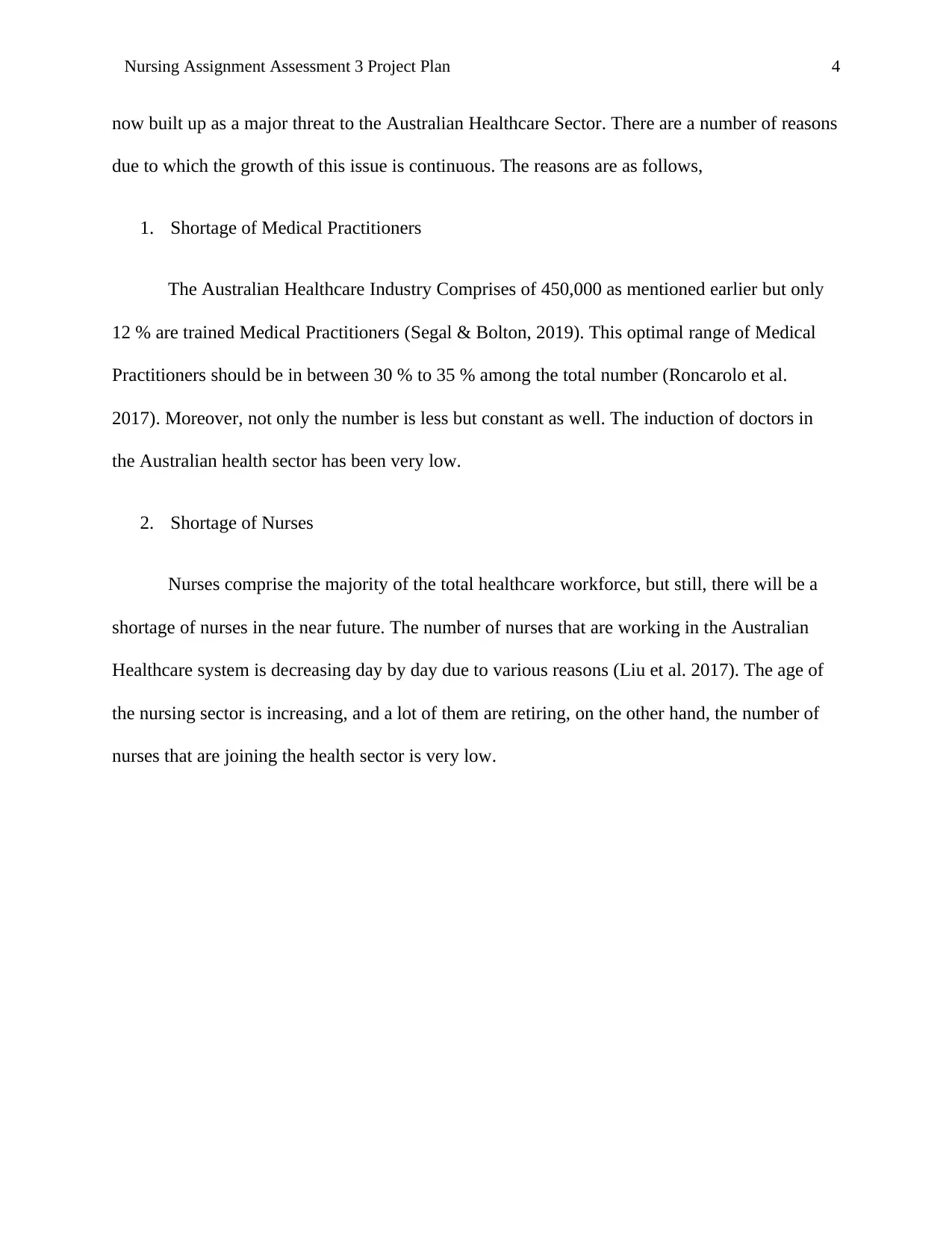
Nursing Assignment Assessment 3 Project Plan 4
now built up as a major threat to the Australian Healthcare Sector. There are a number of reasons
due to which the growth of this issue is continuous. The reasons are as follows,
1. Shortage of Medical Practitioners
The Australian Healthcare Industry Comprises of 450,000 as mentioned earlier but only
12 % are trained Medical Practitioners (Segal & Bolton, 2019). This optimal range of Medical
Practitioners should be in between 30 % to 35 % among the total number (Roncarolo et al.
2017). Moreover, not only the number is less but constant as well. The induction of doctors in
the Australian health sector has been very low.
2. Shortage of Nurses
Nurses comprise the majority of the total healthcare workforce, but still, there will be a
shortage of nurses in the near future. The number of nurses that are working in the Australian
Healthcare system is decreasing day by day due to various reasons (Liu et al. 2017). The age of
the nursing sector is increasing, and a lot of them are retiring, on the other hand, the number of
nurses that are joining the health sector is very low.
now built up as a major threat to the Australian Healthcare Sector. There are a number of reasons
due to which the growth of this issue is continuous. The reasons are as follows,
1. Shortage of Medical Practitioners
The Australian Healthcare Industry Comprises of 450,000 as mentioned earlier but only
12 % are trained Medical Practitioners (Segal & Bolton, 2019). This optimal range of Medical
Practitioners should be in between 30 % to 35 % among the total number (Roncarolo et al.
2017). Moreover, not only the number is less but constant as well. The induction of doctors in
the Australian health sector has been very low.
2. Shortage of Nurses
Nurses comprise the majority of the total healthcare workforce, but still, there will be a
shortage of nurses in the near future. The number of nurses that are working in the Australian
Healthcare system is decreasing day by day due to various reasons (Liu et al. 2017). The age of
the nursing sector is increasing, and a lot of them are retiring, on the other hand, the number of
nurses that are joining the health sector is very low.
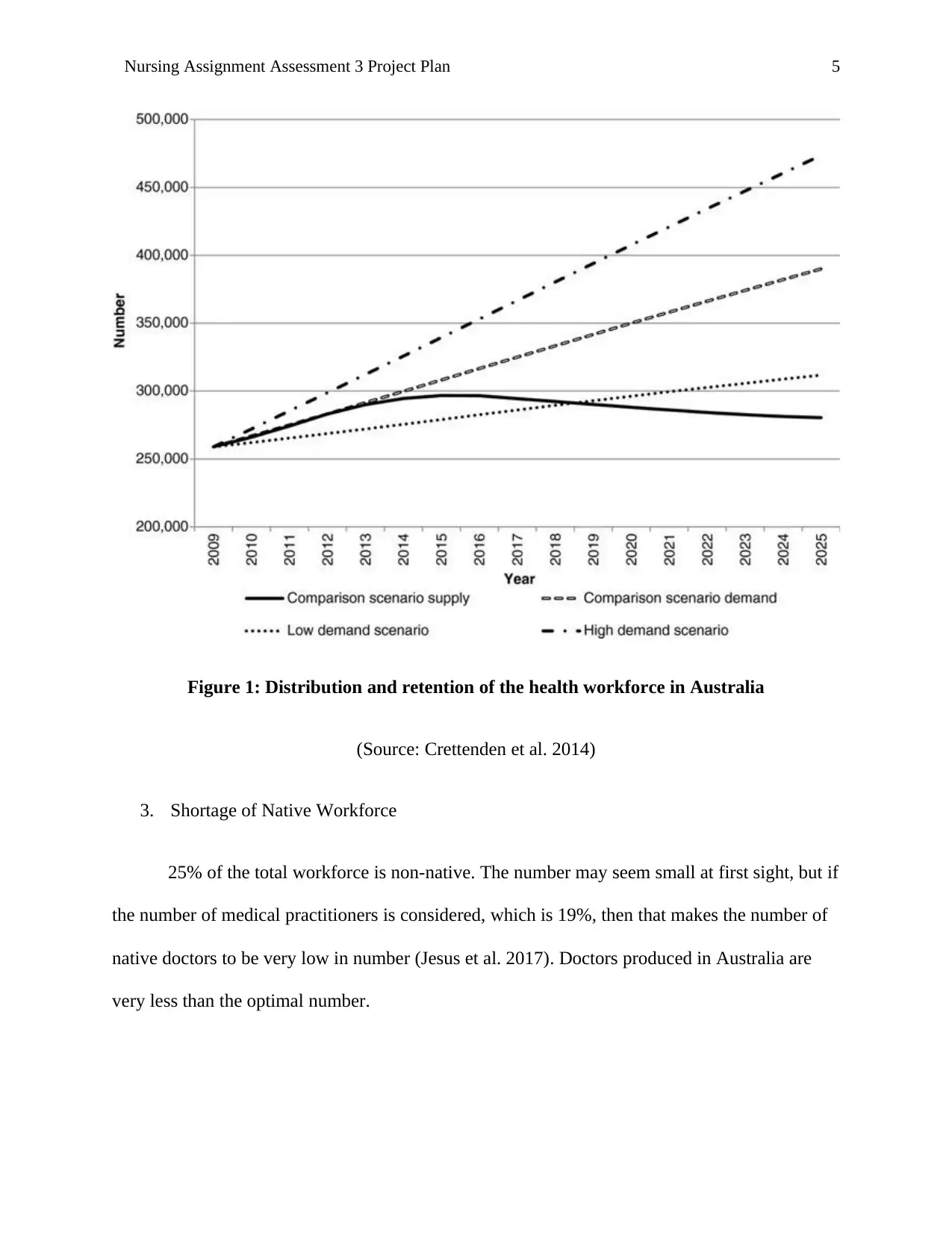
Nursing Assignment Assessment 3 Project Plan 5
Figure 1: Distribution and retention of the health workforce in Australia
(Source: Crettenden et al. 2014)
3. Shortage of Native Workforce
25% of the total workforce is non-native. The number may seem small at first sight, but if
the number of medical practitioners is considered, which is 19%, then that makes the number of
native doctors to be very low in number (Jesus et al. 2017). Doctors produced in Australia are
very less than the optimal number.
Figure 1: Distribution and retention of the health workforce in Australia
(Source: Crettenden et al. 2014)
3. Shortage of Native Workforce
25% of the total workforce is non-native. The number may seem small at first sight, but if
the number of medical practitioners is considered, which is 19%, then that makes the number of
native doctors to be very low in number (Jesus et al. 2017). Doctors produced in Australia are
very less than the optimal number.
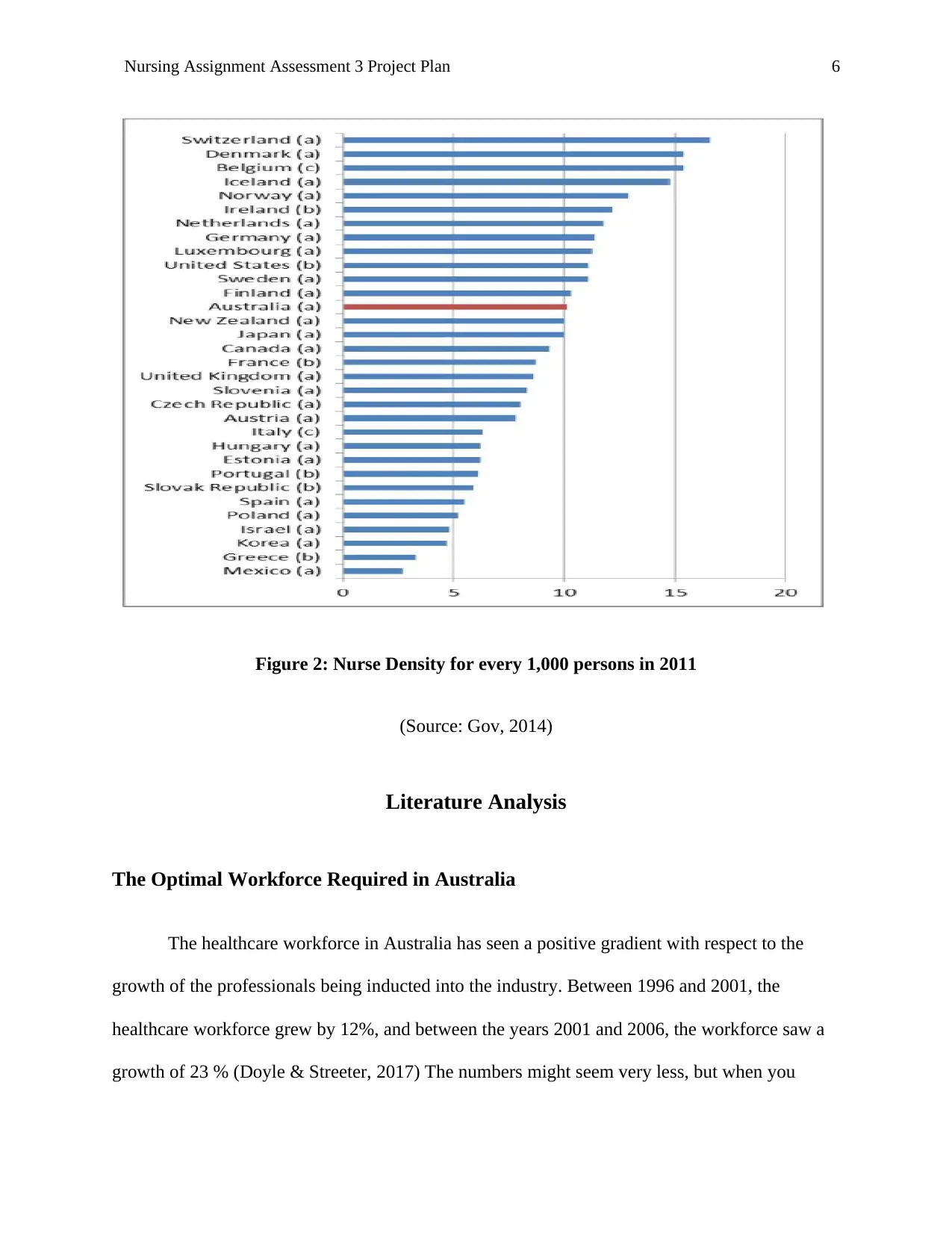
Nursing Assignment Assessment 3 Project Plan 6
Figure 2: Nurse Density for every 1,000 persons in 2011
(Source: Gov, 2014)
Literature Analysis
The Optimal Workforce Required in Australia
The healthcare workforce in Australia has seen a positive gradient with respect to the
growth of the professionals being inducted into the industry. Between 1996 and 2001, the
healthcare workforce grew by 12%, and between the years 2001 and 2006, the workforce saw a
growth of 23 % (Doyle & Streeter, 2017) The numbers might seem very less, but when you
Figure 2: Nurse Density for every 1,000 persons in 2011
(Source: Gov, 2014)
Literature Analysis
The Optimal Workforce Required in Australia
The healthcare workforce in Australia has seen a positive gradient with respect to the
growth of the professionals being inducted into the industry. Between 1996 and 2001, the
healthcare workforce grew by 12%, and between the years 2001 and 2006, the workforce saw a
growth of 23 % (Doyle & Streeter, 2017) The numbers might seem very less, but when you
Paraphrase This Document
Need a fresh take? Get an instant paraphrase of this document with our AI Paraphraser
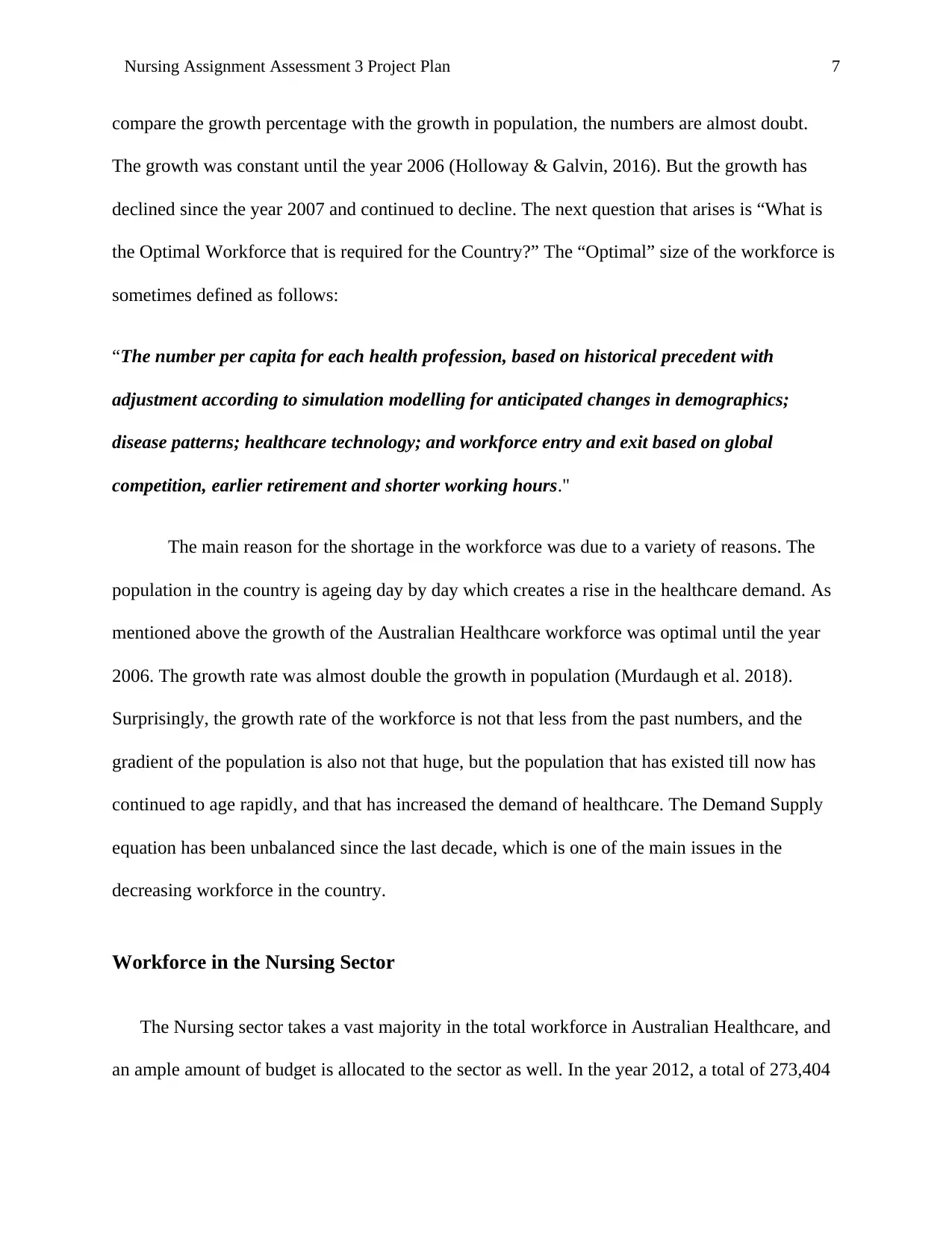
Nursing Assignment Assessment 3 Project Plan 7
compare the growth percentage with the growth in population, the numbers are almost doubt.
The growth was constant until the year 2006 (Holloway & Galvin, 2016). But the growth has
declined since the year 2007 and continued to decline. The next question that arises is “What is
the Optimal Workforce that is required for the Country?” The “Optimal” size of the workforce is
sometimes defined as follows:
“The number per capita for each health profession, based on historical precedent with
adjustment according to simulation modelling for anticipated changes in demographics;
disease patterns; healthcare technology; and workforce entry and exit based on global
competition, earlier retirement and shorter working hours."
The main reason for the shortage in the workforce was due to a variety of reasons. The
population in the country is ageing day by day which creates a rise in the healthcare demand. As
mentioned above the growth of the Australian Healthcare workforce was optimal until the year
2006. The growth rate was almost double the growth in population (Murdaugh et al. 2018).
Surprisingly, the growth rate of the workforce is not that less from the past numbers, and the
gradient of the population is also not that huge, but the population that has existed till now has
continued to age rapidly, and that has increased the demand of healthcare. The Demand Supply
equation has been unbalanced since the last decade, which is one of the main issues in the
decreasing workforce in the country.
Workforce in the Nursing Sector
The Nursing sector takes a vast majority in the total workforce in Australian Healthcare, and
an ample amount of budget is allocated to the sector as well. In the year 2012, a total of 273,404
compare the growth percentage with the growth in population, the numbers are almost doubt.
The growth was constant until the year 2006 (Holloway & Galvin, 2016). But the growth has
declined since the year 2007 and continued to decline. The next question that arises is “What is
the Optimal Workforce that is required for the Country?” The “Optimal” size of the workforce is
sometimes defined as follows:
“The number per capita for each health profession, based on historical precedent with
adjustment according to simulation modelling for anticipated changes in demographics;
disease patterns; healthcare technology; and workforce entry and exit based on global
competition, earlier retirement and shorter working hours."
The main reason for the shortage in the workforce was due to a variety of reasons. The
population in the country is ageing day by day which creates a rise in the healthcare demand. As
mentioned above the growth of the Australian Healthcare workforce was optimal until the year
2006. The growth rate was almost double the growth in population (Murdaugh et al. 2018).
Surprisingly, the growth rate of the workforce is not that less from the past numbers, and the
gradient of the population is also not that huge, but the population that has existed till now has
continued to age rapidly, and that has increased the demand of healthcare. The Demand Supply
equation has been unbalanced since the last decade, which is one of the main issues in the
decreasing workforce in the country.
Workforce in the Nursing Sector
The Nursing sector takes a vast majority in the total workforce in Australian Healthcare, and
an ample amount of budget is allocated to the sector as well. In the year 2012, a total of 273,404
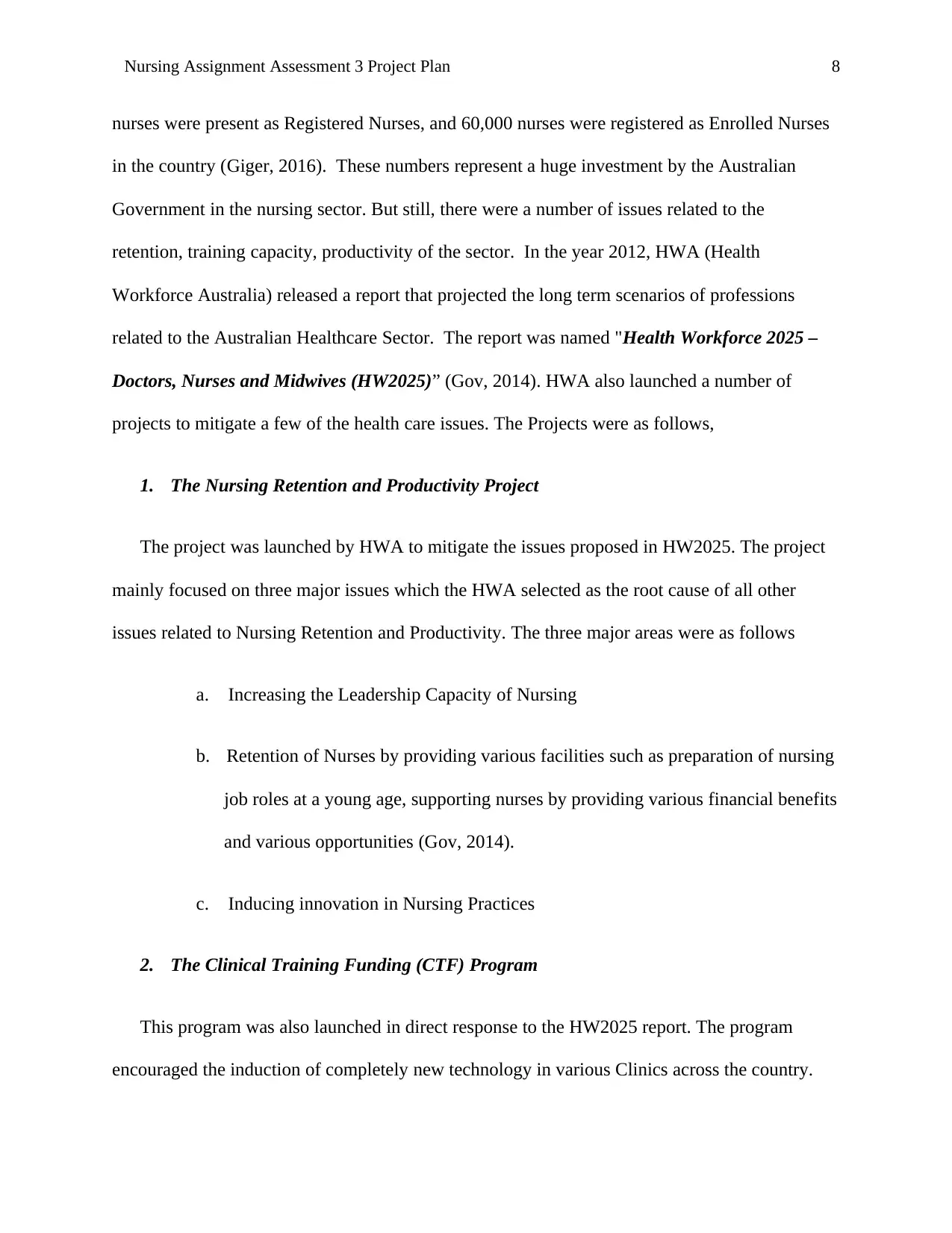
Nursing Assignment Assessment 3 Project Plan 8
nurses were present as Registered Nurses, and 60,000 nurses were registered as Enrolled Nurses
in the country (Giger, 2016). These numbers represent a huge investment by the Australian
Government in the nursing sector. But still, there were a number of issues related to the
retention, training capacity, productivity of the sector. In the year 2012, HWA (Health
Workforce Australia) released a report that projected the long term scenarios of professions
related to the Australian Healthcare Sector. The report was named "Health Workforce 2025 –
Doctors, Nurses and Midwives (HW2025)” (Gov, 2014). HWA also launched a number of
projects to mitigate a few of the health care issues. The Projects were as follows,
1. The Nursing Retention and Productivity Project
The project was launched by HWA to mitigate the issues proposed in HW2025. The project
mainly focused on three major issues which the HWA selected as the root cause of all other
issues related to Nursing Retention and Productivity. The three major areas were as follows
a. Increasing the Leadership Capacity of Nursing
b. Retention of Nurses by providing various facilities such as preparation of nursing
job roles at a young age, supporting nurses by providing various financial benefits
and various opportunities (Gov, 2014).
c. Inducing innovation in Nursing Practices
2. The Clinical Training Funding (CTF) Program
This program was also launched in direct response to the HW2025 report. The program
encouraged the induction of completely new technology in various Clinics across the country.
nurses were present as Registered Nurses, and 60,000 nurses were registered as Enrolled Nurses
in the country (Giger, 2016). These numbers represent a huge investment by the Australian
Government in the nursing sector. But still, there were a number of issues related to the
retention, training capacity, productivity of the sector. In the year 2012, HWA (Health
Workforce Australia) released a report that projected the long term scenarios of professions
related to the Australian Healthcare Sector. The report was named "Health Workforce 2025 –
Doctors, Nurses and Midwives (HW2025)” (Gov, 2014). HWA also launched a number of
projects to mitigate a few of the health care issues. The Projects were as follows,
1. The Nursing Retention and Productivity Project
The project was launched by HWA to mitigate the issues proposed in HW2025. The project
mainly focused on three major issues which the HWA selected as the root cause of all other
issues related to Nursing Retention and Productivity. The three major areas were as follows
a. Increasing the Leadership Capacity of Nursing
b. Retention of Nurses by providing various facilities such as preparation of nursing
job roles at a young age, supporting nurses by providing various financial benefits
and various opportunities (Gov, 2014).
c. Inducing innovation in Nursing Practices
2. The Clinical Training Funding (CTF) Program
This program was also launched in direct response to the HW2025 report. The program
encouraged the induction of completely new technology in various Clinics across the country.
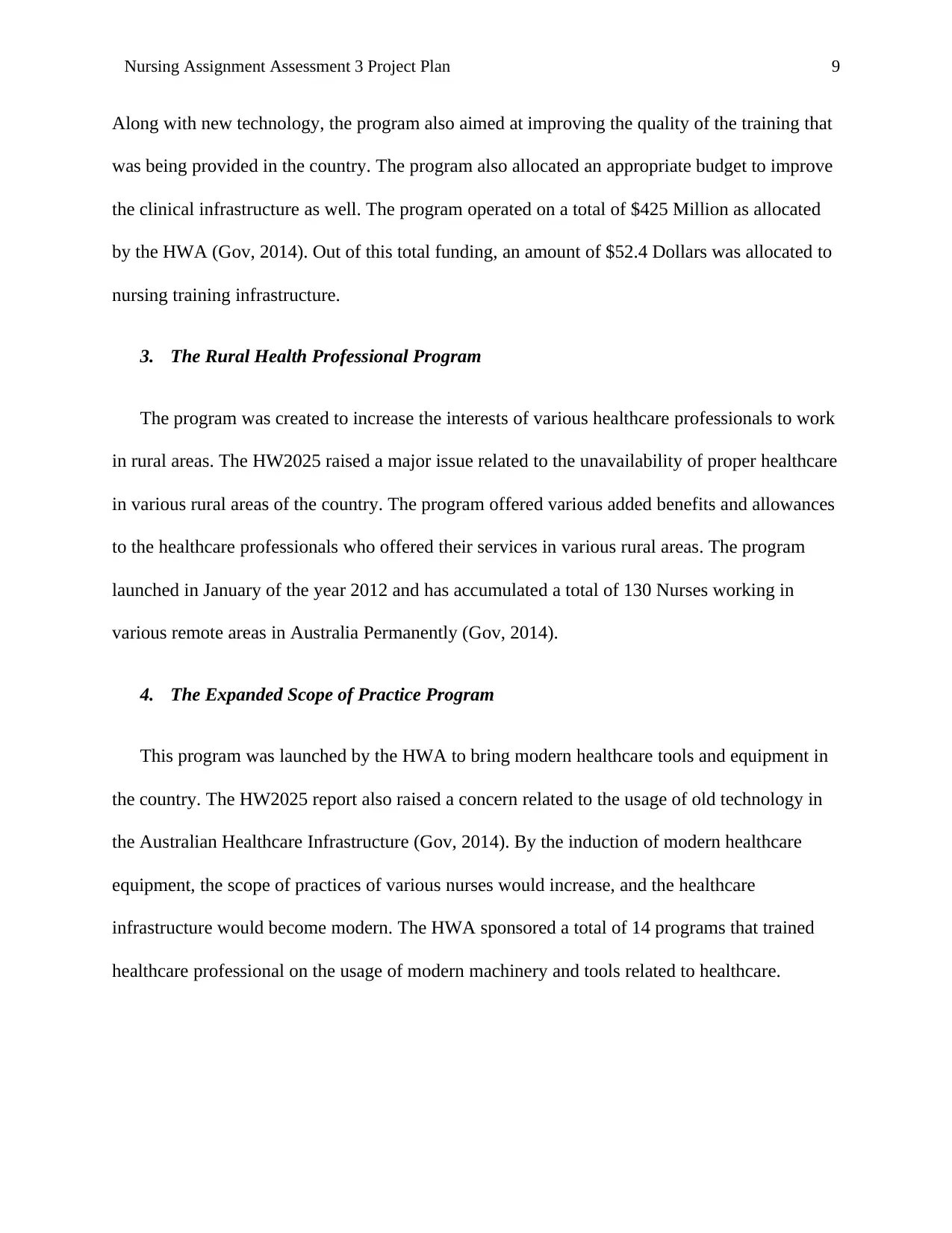
Nursing Assignment Assessment 3 Project Plan 9
Along with new technology, the program also aimed at improving the quality of the training that
was being provided in the country. The program also allocated an appropriate budget to improve
the clinical infrastructure as well. The program operated on a total of $425 Million as allocated
by the HWA (Gov, 2014). Out of this total funding, an amount of $52.4 Dollars was allocated to
nursing training infrastructure.
3. The Rural Health Professional Program
The program was created to increase the interests of various healthcare professionals to work
in rural areas. The HW2025 raised a major issue related to the unavailability of proper healthcare
in various rural areas of the country. The program offered various added benefits and allowances
to the healthcare professionals who offered their services in various rural areas. The program
launched in January of the year 2012 and has accumulated a total of 130 Nurses working in
various remote areas in Australia Permanently (Gov, 2014).
4. The Expanded Scope of Practice Program
This program was launched by the HWA to bring modern healthcare tools and equipment in
the country. The HW2025 report also raised a concern related to the usage of old technology in
the Australian Healthcare Infrastructure (Gov, 2014). By the induction of modern healthcare
equipment, the scope of practices of various nurses would increase, and the healthcare
infrastructure would become modern. The HWA sponsored a total of 14 programs that trained
healthcare professional on the usage of modern machinery and tools related to healthcare.
Along with new technology, the program also aimed at improving the quality of the training that
was being provided in the country. The program also allocated an appropriate budget to improve
the clinical infrastructure as well. The program operated on a total of $425 Million as allocated
by the HWA (Gov, 2014). Out of this total funding, an amount of $52.4 Dollars was allocated to
nursing training infrastructure.
3. The Rural Health Professional Program
The program was created to increase the interests of various healthcare professionals to work
in rural areas. The HW2025 raised a major issue related to the unavailability of proper healthcare
in various rural areas of the country. The program offered various added benefits and allowances
to the healthcare professionals who offered their services in various rural areas. The program
launched in January of the year 2012 and has accumulated a total of 130 Nurses working in
various remote areas in Australia Permanently (Gov, 2014).
4. The Expanded Scope of Practice Program
This program was launched by the HWA to bring modern healthcare tools and equipment in
the country. The HW2025 report also raised a concern related to the usage of old technology in
the Australian Healthcare Infrastructure (Gov, 2014). By the induction of modern healthcare
equipment, the scope of practices of various nurses would increase, and the healthcare
infrastructure would become modern. The HWA sponsored a total of 14 programs that trained
healthcare professional on the usage of modern machinery and tools related to healthcare.
Secure Best Marks with AI Grader
Need help grading? Try our AI Grader for instant feedback on your assignments.
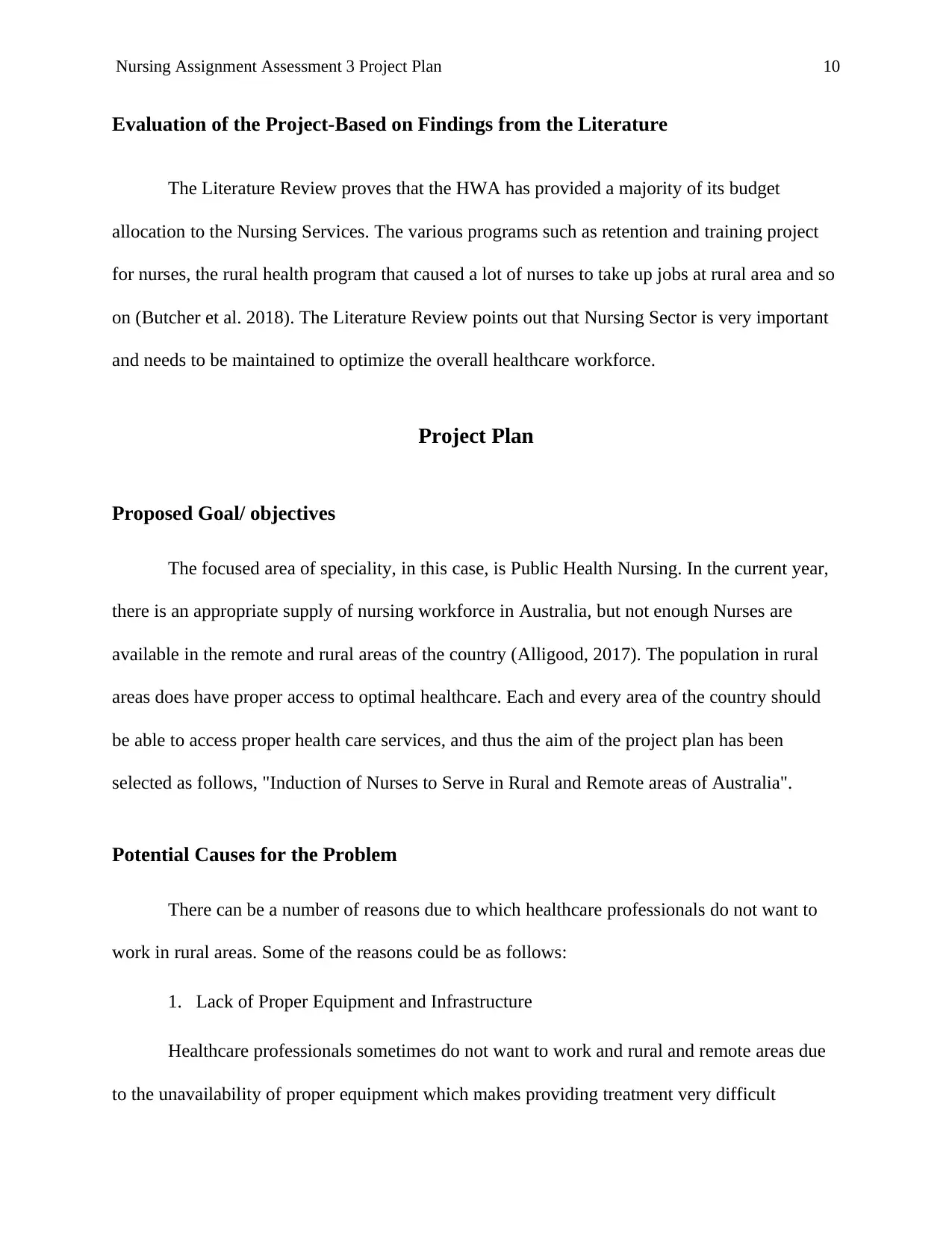
Nursing Assignment Assessment 3 Project Plan 10
Evaluation of the Project-Based on Findings from the Literature
The Literature Review proves that the HWA has provided a majority of its budget
allocation to the Nursing Services. The various programs such as retention and training project
for nurses, the rural health program that caused a lot of nurses to take up jobs at rural area and so
on (Butcher et al. 2018). The Literature Review points out that Nursing Sector is very important
and needs to be maintained to optimize the overall healthcare workforce.
Project Plan
Proposed Goal/ objectives
The focused area of speciality, in this case, is Public Health Nursing. In the current year,
there is an appropriate supply of nursing workforce in Australia, but not enough Nurses are
available in the remote and rural areas of the country (Alligood, 2017). The population in rural
areas does have proper access to optimal healthcare. Each and every area of the country should
be able to access proper health care services, and thus the aim of the project plan has been
selected as follows, "Induction of Nurses to Serve in Rural and Remote areas of Australia".
Potential Causes for the Problem
There can be a number of reasons due to which healthcare professionals do not want to
work in rural areas. Some of the reasons could be as follows:
1. Lack of Proper Equipment and Infrastructure
Healthcare professionals sometimes do not want to work and rural and remote areas due
to the unavailability of proper equipment which makes providing treatment very difficult
Evaluation of the Project-Based on Findings from the Literature
The Literature Review proves that the HWA has provided a majority of its budget
allocation to the Nursing Services. The various programs such as retention and training project
for nurses, the rural health program that caused a lot of nurses to take up jobs at rural area and so
on (Butcher et al. 2018). The Literature Review points out that Nursing Sector is very important
and needs to be maintained to optimize the overall healthcare workforce.
Project Plan
Proposed Goal/ objectives
The focused area of speciality, in this case, is Public Health Nursing. In the current year,
there is an appropriate supply of nursing workforce in Australia, but not enough Nurses are
available in the remote and rural areas of the country (Alligood, 2017). The population in rural
areas does have proper access to optimal healthcare. Each and every area of the country should
be able to access proper health care services, and thus the aim of the project plan has been
selected as follows, "Induction of Nurses to Serve in Rural and Remote areas of Australia".
Potential Causes for the Problem
There can be a number of reasons due to which healthcare professionals do not want to
work in rural areas. Some of the reasons could be as follows:
1. Lack of Proper Equipment and Infrastructure
Healthcare professionals sometimes do not want to work and rural and remote areas due
to the unavailability of proper equipment which makes providing treatment very difficult
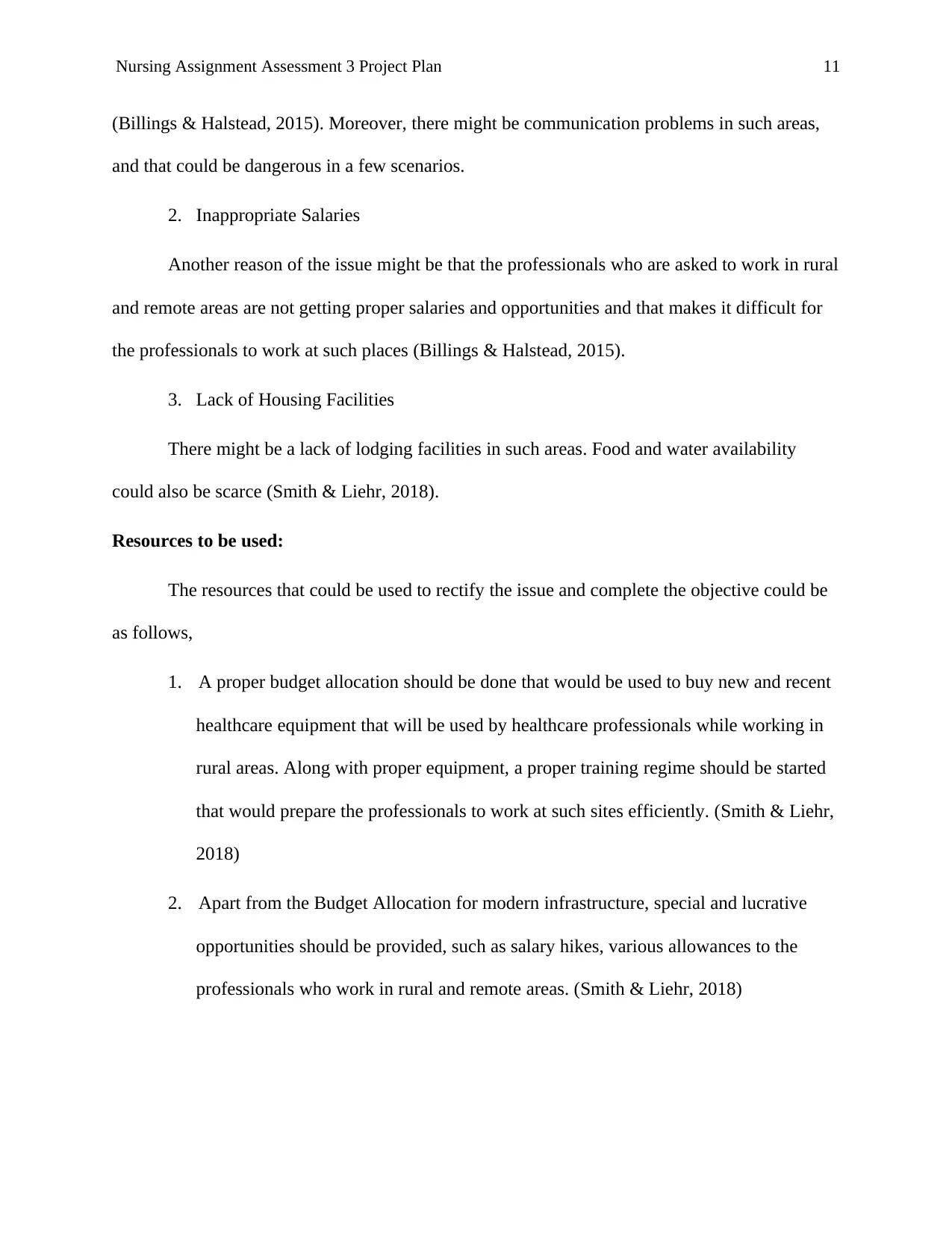
Nursing Assignment Assessment 3 Project Plan 11
(Billings & Halstead, 2015). Moreover, there might be communication problems in such areas,
and that could be dangerous in a few scenarios.
2. Inappropriate Salaries
Another reason of the issue might be that the professionals who are asked to work in rural
and remote areas are not getting proper salaries and opportunities and that makes it difficult for
the professionals to work at such places (Billings & Halstead, 2015).
3. Lack of Housing Facilities
There might be a lack of lodging facilities in such areas. Food and water availability
could also be scarce (Smith & Liehr, 2018).
Resources to be used:
The resources that could be used to rectify the issue and complete the objective could be
as follows,
1. A proper budget allocation should be done that would be used to buy new and recent
healthcare equipment that will be used by healthcare professionals while working in
rural areas. Along with proper equipment, a proper training regime should be started
that would prepare the professionals to work at such sites efficiently. (Smith & Liehr,
2018)
2. Apart from the Budget Allocation for modern infrastructure, special and lucrative
opportunities should be provided, such as salary hikes, various allowances to the
professionals who work in rural and remote areas. (Smith & Liehr, 2018)
(Billings & Halstead, 2015). Moreover, there might be communication problems in such areas,
and that could be dangerous in a few scenarios.
2. Inappropriate Salaries
Another reason of the issue might be that the professionals who are asked to work in rural
and remote areas are not getting proper salaries and opportunities and that makes it difficult for
the professionals to work at such places (Billings & Halstead, 2015).
3. Lack of Housing Facilities
There might be a lack of lodging facilities in such areas. Food and water availability
could also be scarce (Smith & Liehr, 2018).
Resources to be used:
The resources that could be used to rectify the issue and complete the objective could be
as follows,
1. A proper budget allocation should be done that would be used to buy new and recent
healthcare equipment that will be used by healthcare professionals while working in
rural areas. Along with proper equipment, a proper training regime should be started
that would prepare the professionals to work at such sites efficiently. (Smith & Liehr,
2018)
2. Apart from the Budget Allocation for modern infrastructure, special and lucrative
opportunities should be provided, such as salary hikes, various allowances to the
professionals who work in rural and remote areas. (Smith & Liehr, 2018)
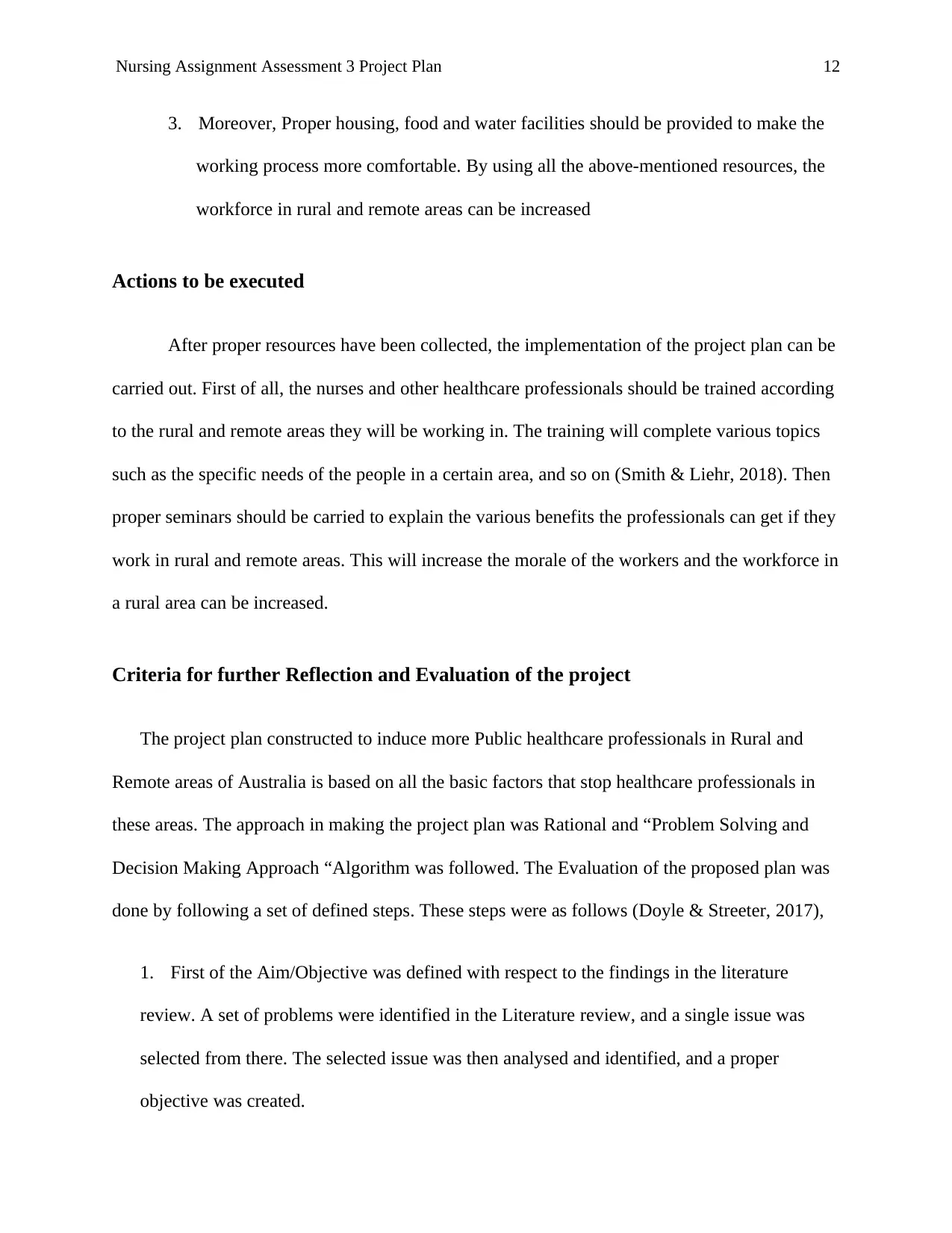
Nursing Assignment Assessment 3 Project Plan 12
3. Moreover, Proper housing, food and water facilities should be provided to make the
working process more comfortable. By using all the above-mentioned resources, the
workforce in rural and remote areas can be increased
Actions to be executed
After proper resources have been collected, the implementation of the project plan can be
carried out. First of all, the nurses and other healthcare professionals should be trained according
to the rural and remote areas they will be working in. The training will complete various topics
such as the specific needs of the people in a certain area, and so on (Smith & Liehr, 2018). Then
proper seminars should be carried to explain the various benefits the professionals can get if they
work in rural and remote areas. This will increase the morale of the workers and the workforce in
a rural area can be increased.
Criteria for further Reflection and Evaluation of the project
The project plan constructed to induce more Public healthcare professionals in Rural and
Remote areas of Australia is based on all the basic factors that stop healthcare professionals in
these areas. The approach in making the project plan was Rational and “Problem Solving and
Decision Making Approach “Algorithm was followed. The Evaluation of the proposed plan was
done by following a set of defined steps. These steps were as follows (Doyle & Streeter, 2017),
1. First of the Aim/Objective was defined with respect to the findings in the literature
review. A set of problems were identified in the Literature review, and a single issue was
selected from there. The selected issue was then analysed and identified, and a proper
objective was created.
3. Moreover, Proper housing, food and water facilities should be provided to make the
working process more comfortable. By using all the above-mentioned resources, the
workforce in rural and remote areas can be increased
Actions to be executed
After proper resources have been collected, the implementation of the project plan can be
carried out. First of all, the nurses and other healthcare professionals should be trained according
to the rural and remote areas they will be working in. The training will complete various topics
such as the specific needs of the people in a certain area, and so on (Smith & Liehr, 2018). Then
proper seminars should be carried to explain the various benefits the professionals can get if they
work in rural and remote areas. This will increase the morale of the workers and the workforce in
a rural area can be increased.
Criteria for further Reflection and Evaluation of the project
The project plan constructed to induce more Public healthcare professionals in Rural and
Remote areas of Australia is based on all the basic factors that stop healthcare professionals in
these areas. The approach in making the project plan was Rational and “Problem Solving and
Decision Making Approach “Algorithm was followed. The Evaluation of the proposed plan was
done by following a set of defined steps. These steps were as follows (Doyle & Streeter, 2017),
1. First of the Aim/Objective was defined with respect to the findings in the literature
review. A set of problems were identified in the Literature review, and a single issue was
selected from there. The selected issue was then analysed and identified, and a proper
objective was created.
Paraphrase This Document
Need a fresh take? Get an instant paraphrase of this document with our AI Paraphraser
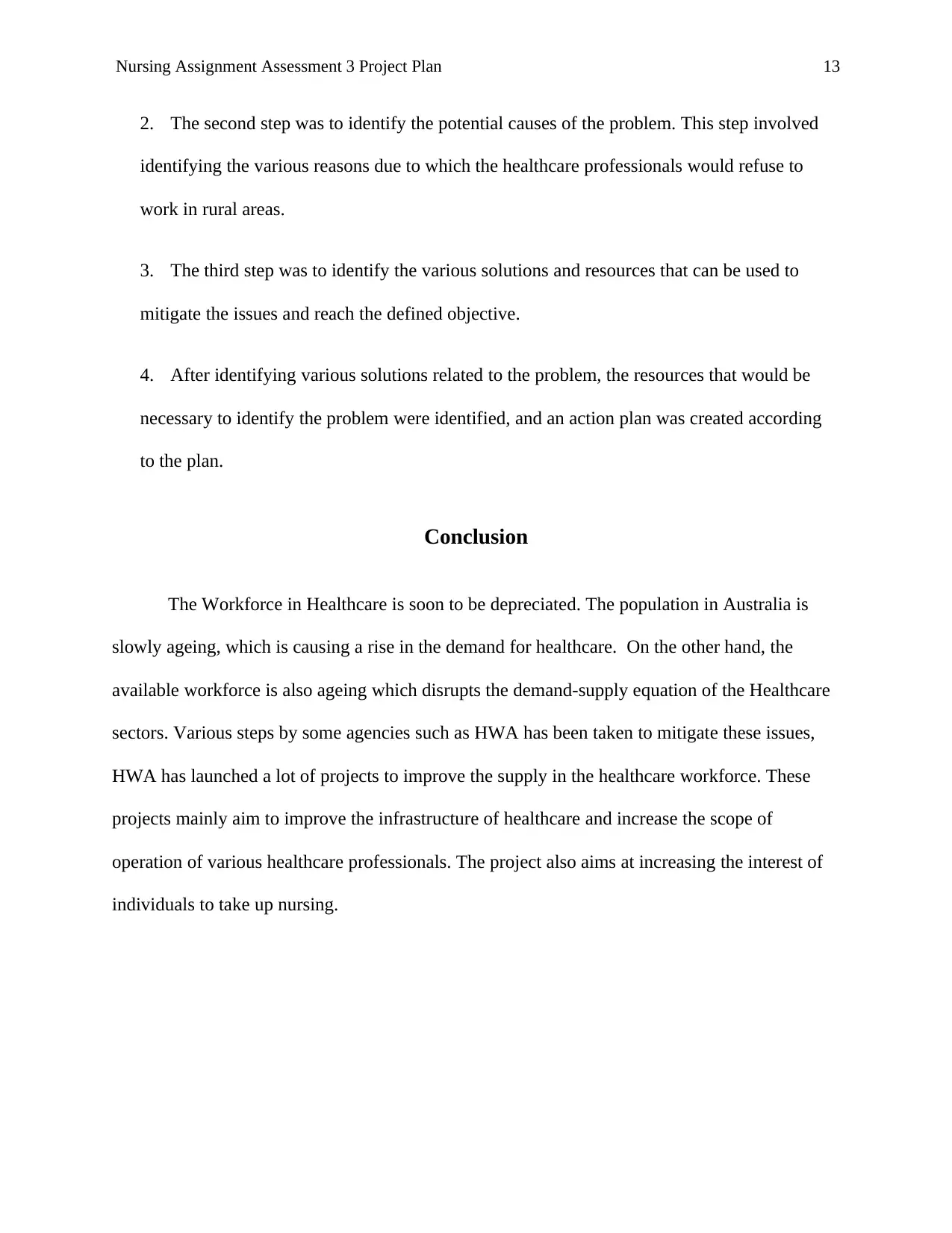
Nursing Assignment Assessment 3 Project Plan 13
2. The second step was to identify the potential causes of the problem. This step involved
identifying the various reasons due to which the healthcare professionals would refuse to
work in rural areas.
3. The third step was to identify the various solutions and resources that can be used to
mitigate the issues and reach the defined objective.
4. After identifying various solutions related to the problem, the resources that would be
necessary to identify the problem were identified, and an action plan was created according
to the plan.
Conclusion
The Workforce in Healthcare is soon to be depreciated. The population in Australia is
slowly ageing, which is causing a rise in the demand for healthcare. On the other hand, the
available workforce is also ageing which disrupts the demand-supply equation of the Healthcare
sectors. Various steps by some agencies such as HWA has been taken to mitigate these issues,
HWA has launched a lot of projects to improve the supply in the healthcare workforce. These
projects mainly aim to improve the infrastructure of healthcare and increase the scope of
operation of various healthcare professionals. The project also aims at increasing the interest of
individuals to take up nursing.
2. The second step was to identify the potential causes of the problem. This step involved
identifying the various reasons due to which the healthcare professionals would refuse to
work in rural areas.
3. The third step was to identify the various solutions and resources that can be used to
mitigate the issues and reach the defined objective.
4. After identifying various solutions related to the problem, the resources that would be
necessary to identify the problem were identified, and an action plan was created according
to the plan.
Conclusion
The Workforce in Healthcare is soon to be depreciated. The population in Australia is
slowly ageing, which is causing a rise in the demand for healthcare. On the other hand, the
available workforce is also ageing which disrupts the demand-supply equation of the Healthcare
sectors. Various steps by some agencies such as HWA has been taken to mitigate these issues,
HWA has launched a lot of projects to improve the supply in the healthcare workforce. These
projects mainly aim to improve the infrastructure of healthcare and increase the scope of
operation of various healthcare professionals. The project also aims at increasing the interest of
individuals to take up nursing.
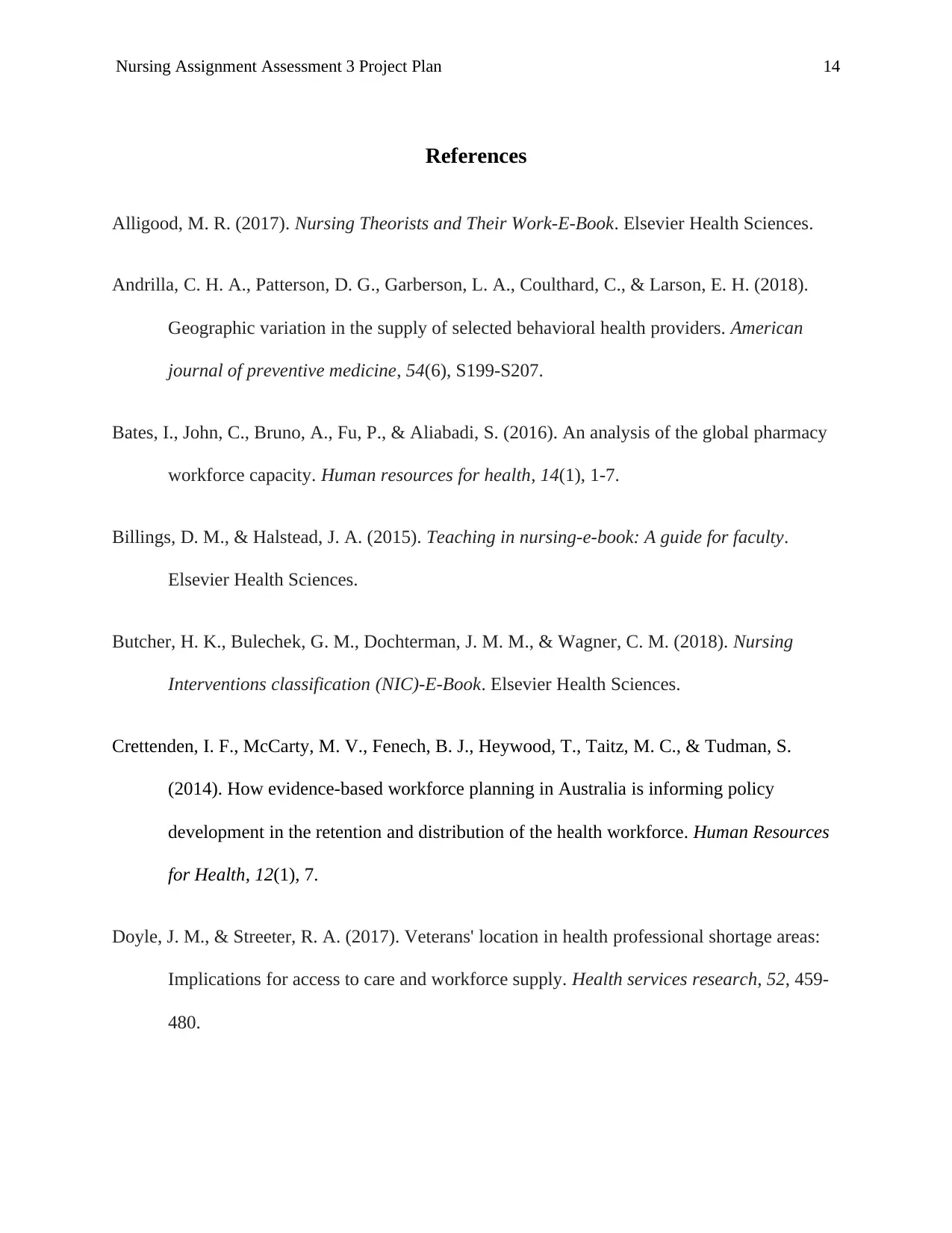
Nursing Assignment Assessment 3 Project Plan 14
References
Alligood, M. R. (2017). Nursing Theorists and Their Work-E-Book. Elsevier Health Sciences.
Andrilla, C. H. A., Patterson, D. G., Garberson, L. A., Coulthard, C., & Larson, E. H. (2018).
Geographic variation in the supply of selected behavioral health providers. American
journal of preventive medicine, 54(6), S199-S207.
Bates, I., John, C., Bruno, A., Fu, P., & Aliabadi, S. (2016). An analysis of the global pharmacy
workforce capacity. Human resources for health, 14(1), 1-7.
Billings, D. M., & Halstead, J. A. (2015). Teaching in nursing-e-book: A guide for faculty.
Elsevier Health Sciences.
Butcher, H. K., Bulechek, G. M., Dochterman, J. M. M., & Wagner, C. M. (2018). Nursing
Interventions classification (NIC)-E-Book. Elsevier Health Sciences.
Crettenden, I. F., McCarty, M. V., Fenech, B. J., Heywood, T., Taitz, M. C., & Tudman, S.
(2014). How evidence-based workforce planning in Australia is informing policy
development in the retention and distribution of the health workforce. Human Resources
for Health, 12(1), 7.
Doyle, J. M., & Streeter, R. A. (2017). Veterans' location in health professional shortage areas:
Implications for access to care and workforce supply. Health services research, 52, 459-
480.
References
Alligood, M. R. (2017). Nursing Theorists and Their Work-E-Book. Elsevier Health Sciences.
Andrilla, C. H. A., Patterson, D. G., Garberson, L. A., Coulthard, C., & Larson, E. H. (2018).
Geographic variation in the supply of selected behavioral health providers. American
journal of preventive medicine, 54(6), S199-S207.
Bates, I., John, C., Bruno, A., Fu, P., & Aliabadi, S. (2016). An analysis of the global pharmacy
workforce capacity. Human resources for health, 14(1), 1-7.
Billings, D. M., & Halstead, J. A. (2015). Teaching in nursing-e-book: A guide for faculty.
Elsevier Health Sciences.
Butcher, H. K., Bulechek, G. M., Dochterman, J. M. M., & Wagner, C. M. (2018). Nursing
Interventions classification (NIC)-E-Book. Elsevier Health Sciences.
Crettenden, I. F., McCarty, M. V., Fenech, B. J., Heywood, T., Taitz, M. C., & Tudman, S.
(2014). How evidence-based workforce planning in Australia is informing policy
development in the retention and distribution of the health workforce. Human Resources
for Health, 12(1), 7.
Doyle, J. M., & Streeter, R. A. (2017). Veterans' location in health professional shortage areas:
Implications for access to care and workforce supply. Health services research, 52, 459-
480.
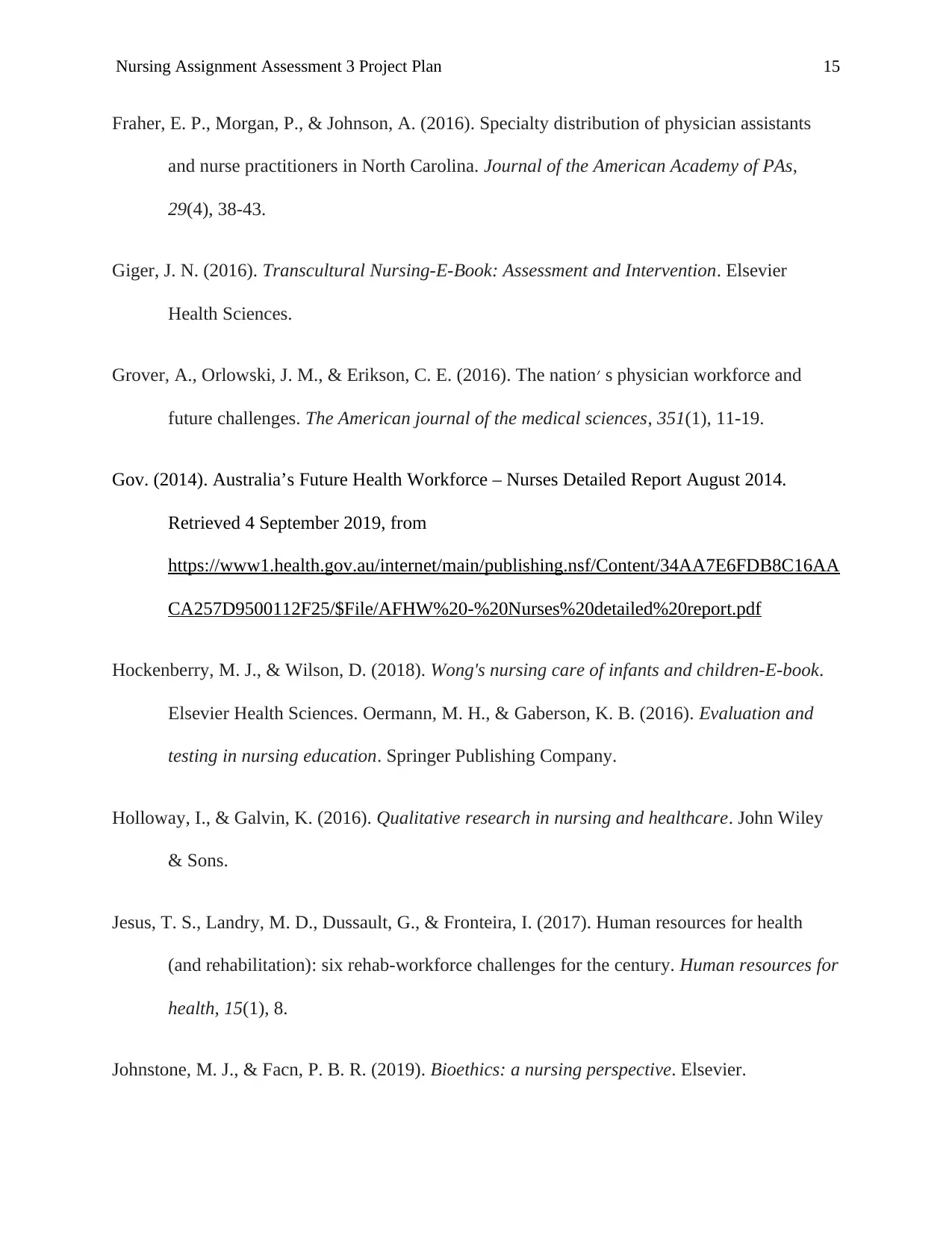
Nursing Assignment Assessment 3 Project Plan 15
Fraher, E. P., Morgan, P., & Johnson, A. (2016). Specialty distribution of physician assistants
and nurse practitioners in North Carolina. Journal of the American Academy of PAs,
29(4), 38-43.
Giger, J. N. (2016). Transcultural Nursing-E-Book: Assessment and Intervention. Elsevier
Health Sciences.
Grover, A., Orlowski, J. M., & Erikson, C. E. (2016). The nation׳ s physician workforce and
future challenges. The American journal of the medical sciences, 351(1), 11-19.
Gov. (2014). Australia’s Future Health Workforce – Nurses Detailed Report August 2014.
Retrieved 4 September 2019, from
https://www1.health.gov.au/internet/main/publishing.nsf/Content/34AA7E6FDB8C16AA
CA257D9500112F25/$File/AFHW%20-%20Nurses%20detailed%20report.pdf
Hockenberry, M. J., & Wilson, D. (2018). Wong's nursing care of infants and children-E-book.
Elsevier Health Sciences. Oermann, M. H., & Gaberson, K. B. (2016). Evaluation and
testing in nursing education. Springer Publishing Company.
Holloway, I., & Galvin, K. (2016). Qualitative research in nursing and healthcare. John Wiley
& Sons.
Jesus, T. S., Landry, M. D., Dussault, G., & Fronteira, I. (2017). Human resources for health
(and rehabilitation): six rehab-workforce challenges for the century. Human resources for
health, 15(1), 8.
Johnstone, M. J., & Facn, P. B. R. (2019). Bioethics: a nursing perspective. Elsevier.
Fraher, E. P., Morgan, P., & Johnson, A. (2016). Specialty distribution of physician assistants
and nurse practitioners in North Carolina. Journal of the American Academy of PAs,
29(4), 38-43.
Giger, J. N. (2016). Transcultural Nursing-E-Book: Assessment and Intervention. Elsevier
Health Sciences.
Grover, A., Orlowski, J. M., & Erikson, C. E. (2016). The nation׳ s physician workforce and
future challenges. The American journal of the medical sciences, 351(1), 11-19.
Gov. (2014). Australia’s Future Health Workforce – Nurses Detailed Report August 2014.
Retrieved 4 September 2019, from
https://www1.health.gov.au/internet/main/publishing.nsf/Content/34AA7E6FDB8C16AA
CA257D9500112F25/$File/AFHW%20-%20Nurses%20detailed%20report.pdf
Hockenberry, M. J., & Wilson, D. (2018). Wong's nursing care of infants and children-E-book.
Elsevier Health Sciences. Oermann, M. H., & Gaberson, K. B. (2016). Evaluation and
testing in nursing education. Springer Publishing Company.
Holloway, I., & Galvin, K. (2016). Qualitative research in nursing and healthcare. John Wiley
& Sons.
Jesus, T. S., Landry, M. D., Dussault, G., & Fronteira, I. (2017). Human resources for health
(and rehabilitation): six rehab-workforce challenges for the century. Human resources for
health, 15(1), 8.
Johnstone, M. J., & Facn, P. B. R. (2019). Bioethics: a nursing perspective. Elsevier.
Secure Best Marks with AI Grader
Need help grading? Try our AI Grader for instant feedback on your assignments.

Nursing Assignment Assessment 3 Project Plan 16
Lasala, K. (2017). Nursing workforce issues in rural and urban settings: Looking at the
difference in recruitment, retention and distribution. Online Journal of Rural Nursing and
Health Care, 1(1), 8-24.
Liu, J. X., Goryakin, Y., Maeda, A., Bruckner, T., & Scheffler, R. (2017). Global health
workforce labor market projections for 2030. Human resources for health, 15(1), 11.
Murdaugh, C. L., Parsons, M. A., & Pender, N. J. (2018). Health promotion in nursing practice.
Pearson Education Canada.
Negin, J., Rozea, A., Cloyd, B., & Martiniuk, A.L.C., (2013). Foreign-born health workers in
Australia: an analysis of census data. Retrieved 5 September 2019, from
https://www.ncbi.nlm.nih.gov/pmc/articles/PMC3882294/
Roncarolo, F., Boivin, A., Denis, J. L., Hébert, R., & Lehoux, P. (2017). What do we know about
the needs and challenges of health systems? A scoping review of the international
literature. BMC health services research, 17(1), 636.
Segal, L. & Bolton, T. (2019). Issues facing the future health care workforce: the importance of
demand modelling. Retrieved 5 September 2019, from
https://anzhealthpolicy.biomedcentral.com/articles/10.1186/1743-8462-6-12
Smith, M. J., & Liehr, P. R. (Eds.). (2018). Middle range theory for nursing. Springer Publishing
Company.
Lasala, K. (2017). Nursing workforce issues in rural and urban settings: Looking at the
difference in recruitment, retention and distribution. Online Journal of Rural Nursing and
Health Care, 1(1), 8-24.
Liu, J. X., Goryakin, Y., Maeda, A., Bruckner, T., & Scheffler, R. (2017). Global health
workforce labor market projections for 2030. Human resources for health, 15(1), 11.
Murdaugh, C. L., Parsons, M. A., & Pender, N. J. (2018). Health promotion in nursing practice.
Pearson Education Canada.
Negin, J., Rozea, A., Cloyd, B., & Martiniuk, A.L.C., (2013). Foreign-born health workers in
Australia: an analysis of census data. Retrieved 5 September 2019, from
https://www.ncbi.nlm.nih.gov/pmc/articles/PMC3882294/
Roncarolo, F., Boivin, A., Denis, J. L., Hébert, R., & Lehoux, P. (2017). What do we know about
the needs and challenges of health systems? A scoping review of the international
literature. BMC health services research, 17(1), 636.
Segal, L. & Bolton, T. (2019). Issues facing the future health care workforce: the importance of
demand modelling. Retrieved 5 September 2019, from
https://anzhealthpolicy.biomedcentral.com/articles/10.1186/1743-8462-6-12
Smith, M. J., & Liehr, P. R. (Eds.). (2018). Middle range theory for nursing. Springer Publishing
Company.
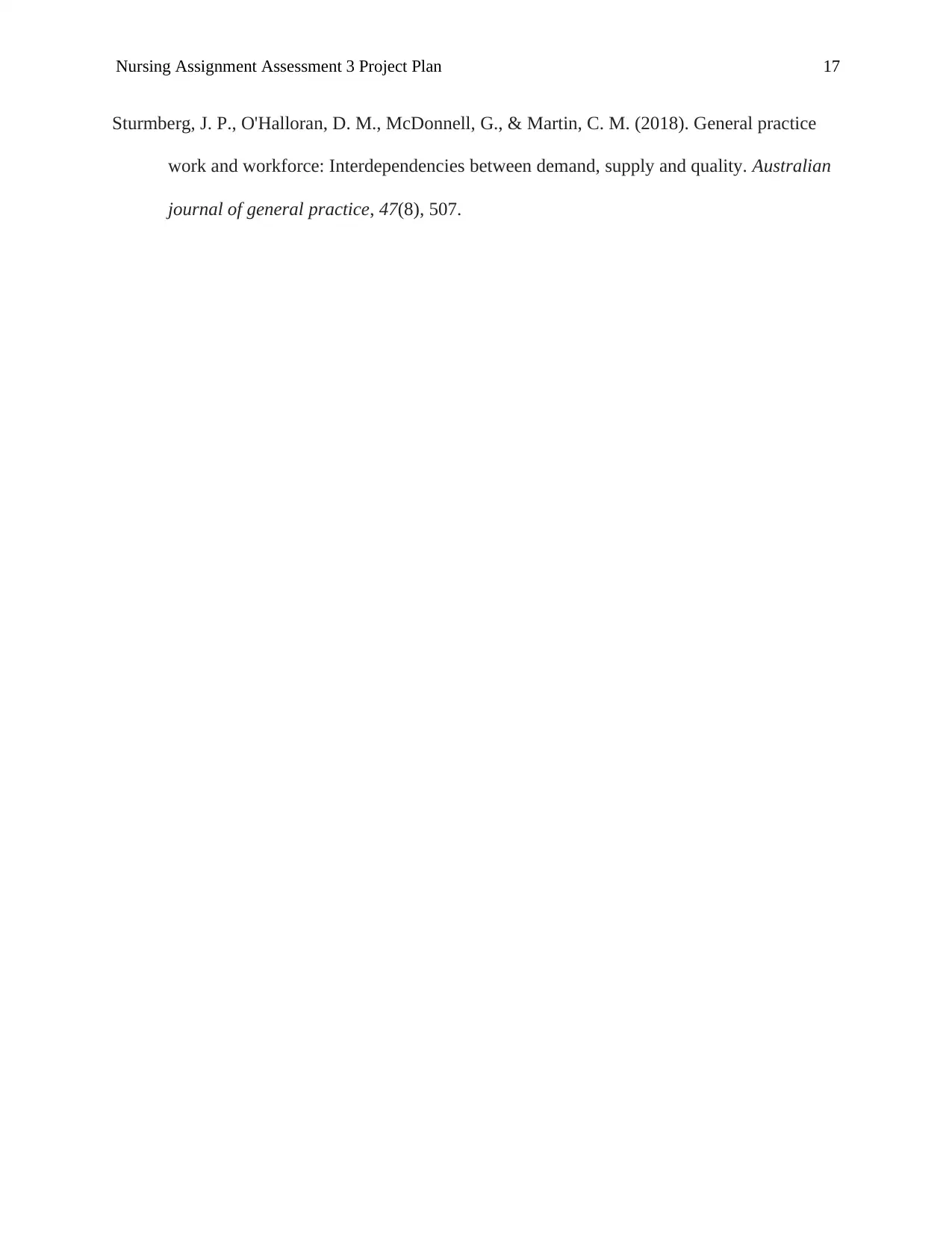
Nursing Assignment Assessment 3 Project Plan 17
Sturmberg, J. P., O'Halloran, D. M., McDonnell, G., & Martin, C. M. (2018). General practice
work and workforce: Interdependencies between demand, supply and quality. Australian
journal of general practice, 47(8), 507.
Sturmberg, J. P., O'Halloran, D. M., McDonnell, G., & Martin, C. M. (2018). General practice
work and workforce: Interdependencies between demand, supply and quality. Australian
journal of general practice, 47(8), 507.
1 out of 18
Related Documents
Your All-in-One AI-Powered Toolkit for Academic Success.
+13062052269
info@desklib.com
Available 24*7 on WhatsApp / Email
![[object Object]](/_next/static/media/star-bottom.7253800d.svg)
Unlock your academic potential
© 2024 | Zucol Services PVT LTD | All rights reserved.





